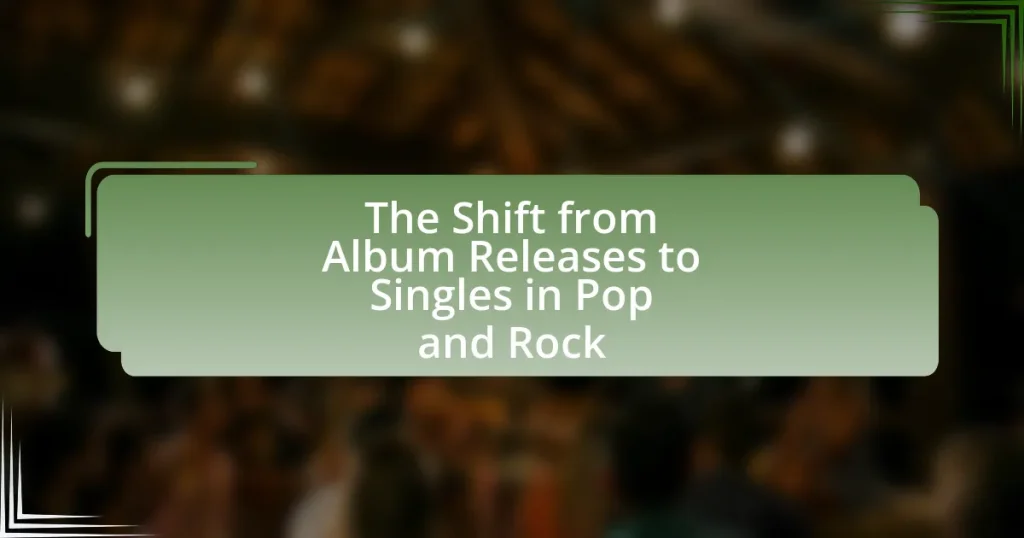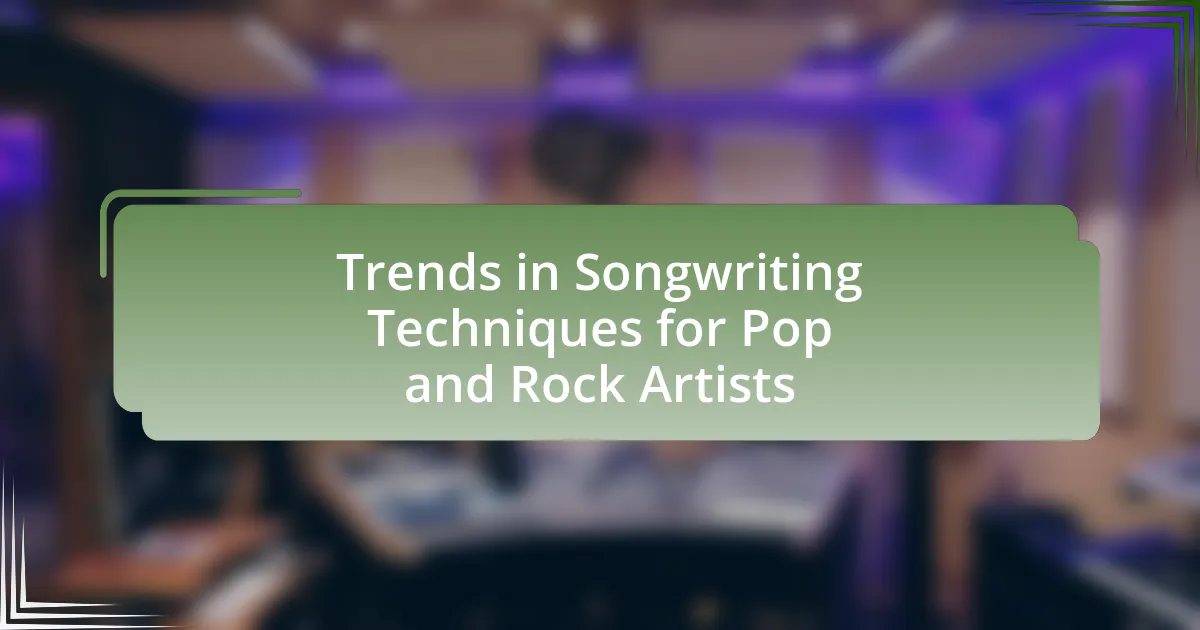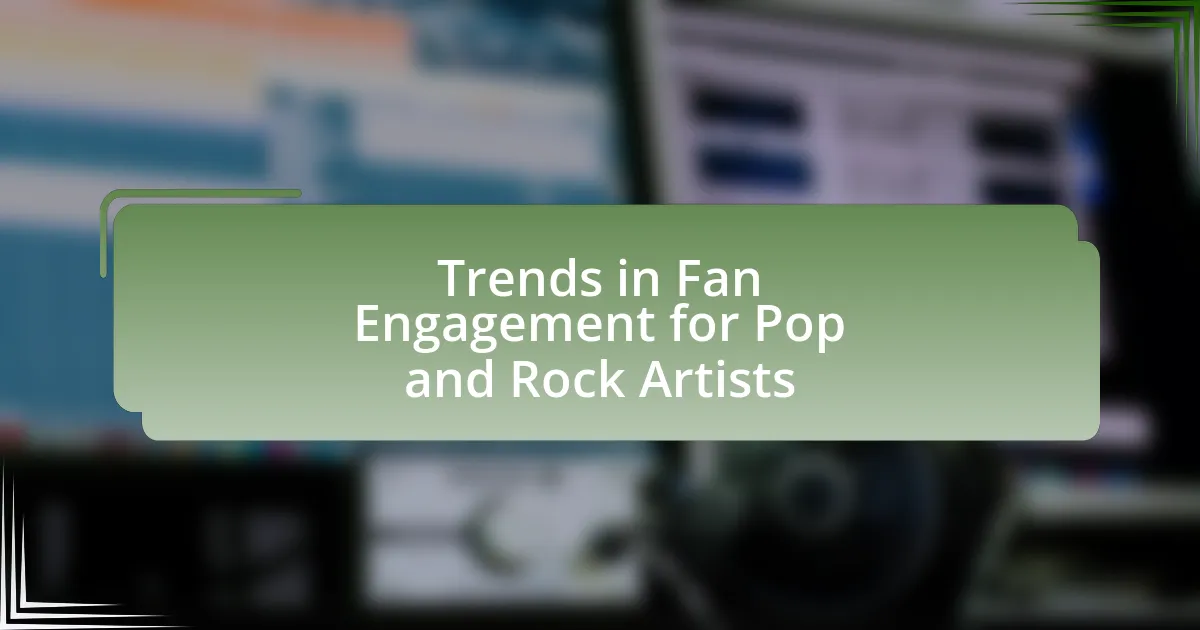The article examines the significant shift from album releases to singles in the pop and rock music genres, driven by changes in music consumption patterns due to digital platforms and streaming services. It highlights how this transition began in the early 2000s, with singles now accounting for over 80% of music consumption in the U.S., as reported by the Recording Industry Association of America (RIAA). The article discusses the evolution of release formats, the historical factors influencing this trend, and the impact of technological advancements on music consumption. Additionally, it explores the financial implications for artists, differences in audience engagement, and the marketing strategies that have adapted to prioritize singles over albums. The piece also addresses the challenges and benefits for both artists and listeners in this evolving landscape.
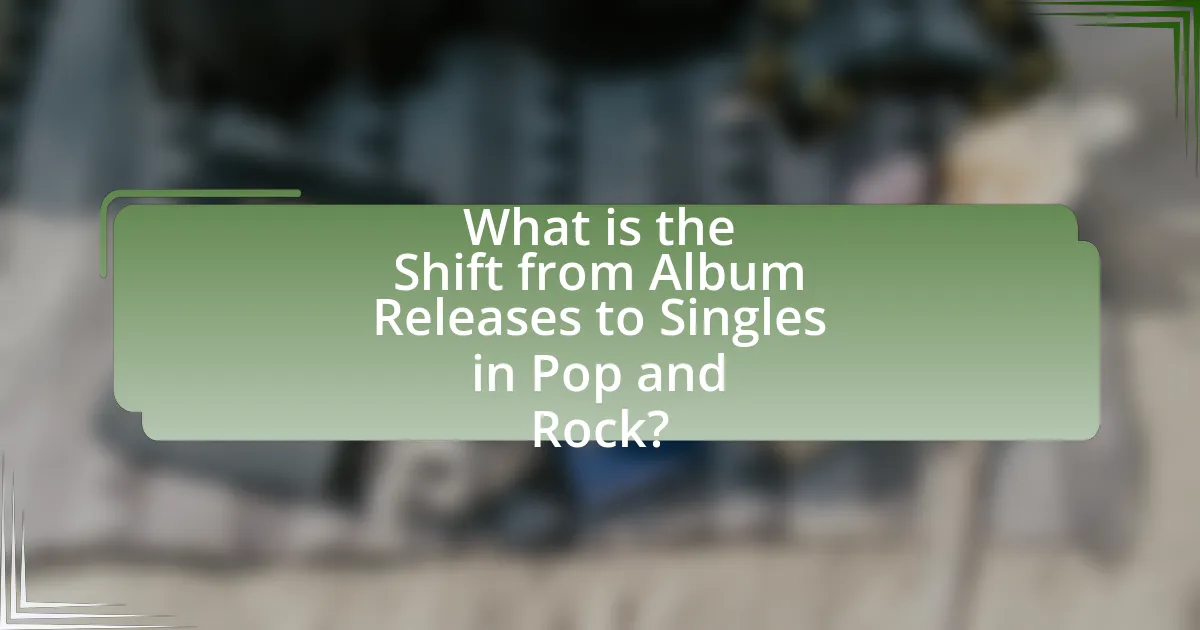
What is the Shift from Album Releases to Singles in Pop and Rock?
The shift from album releases to singles in pop and rock reflects a significant change in music consumption patterns, driven by digital platforms and streaming services. This transition began in the early 2000s as platforms like iTunes and later Spotify allowed listeners to purchase or stream individual tracks rather than entire albums. According to a 2021 report by the Recording Industry Association of America (RIAA), single track sales have consistently outpaced album sales, with singles accounting for over 80% of music consumption in the U.S. This trend indicates that artists are increasingly focusing on releasing standalone singles to maximize engagement and reach, aligning with the shorter attention spans of modern listeners.
How has the music industry evolved in terms of release formats?
The music industry has evolved significantly in terms of release formats, transitioning from traditional album releases to a focus on singles. This shift has been driven by changes in consumer behavior, particularly the rise of digital streaming platforms like Spotify and Apple Music, which prioritize individual tracks over full albums. For instance, data from the Recording Industry Association of America (RIAA) indicates that in 2020, single track sales accounted for 80% of all music sales, highlighting the preference for singles among listeners. Additionally, artists now often release multiple singles leading up to an album, creating a continuous engagement with their audience and adapting to the fast-paced consumption habits of modern listeners.
What historical factors contributed to the rise of singles over albums?
The rise of singles over albums was primarily influenced by technological advancements and changing consumer behavior. The introduction of the 45 RPM vinyl record in the 1940s allowed for shorter, more accessible music formats, making singles more appealing to listeners. Additionally, the emergence of radio as a dominant medium in the 1950s prioritized hit songs, further promoting the single format. The digital revolution in the late 1990s and early 2000s, particularly with the advent of MP3s and platforms like iTunes, shifted consumer preferences towards purchasing individual tracks rather than full albums. This trend was supported by the decline of physical album sales and the rise of streaming services, which often emphasize singles in their playlists.
How have technological advancements influenced music consumption?
Technological advancements have significantly influenced music consumption by facilitating the shift from album releases to singles in pop and rock music. The rise of digital platforms, such as streaming services like Spotify and Apple Music, has enabled listeners to access individual tracks easily, leading to a preference for singles over full albums. According to a report by the Recording Industry Association of America (RIAA), in 2020, single track sales accounted for 80% of all digital music sales, highlighting this trend. Additionally, social media platforms have allowed artists to promote singles more effectively, further driving consumer behavior towards individual songs rather than traditional album formats.
Why are artists increasingly favoring singles over albums?
Artists are increasingly favoring singles over albums due to the changing dynamics of music consumption and the desire for immediate engagement with audiences. The rise of streaming platforms has shifted listener behavior, with data indicating that consumers prefer to listen to individual tracks rather than full albums; for instance, Spotify reported that over 50% of its streams come from singles. This trend allows artists to maintain relevance and visibility in a fast-paced digital landscape, as releasing singles more frequently keeps them in the public eye and encourages ongoing interaction with fans. Additionally, the financial model of streaming favors singles, as artists can generate revenue from multiple releases rather than waiting for an album to accumulate streams.
What are the financial implications of releasing singles?
Releasing singles can significantly impact an artist’s financial performance by generating immediate revenue and increasing streaming numbers. Singles often lead to higher chart placements, which can attract more listeners and result in increased sales and streaming royalties. For instance, according to the Recording Industry Association of America (RIAA), streaming accounted for 83% of the U.S. music industry’s revenue in 2020, highlighting the importance of singles in driving income through platforms like Spotify and Apple Music. Additionally, successful singles can enhance an artist’s visibility, leading to more lucrative touring opportunities and merchandise sales, further contributing to their overall financial success.
How does audience engagement differ between singles and albums?
Audience engagement differs significantly between singles and albums, primarily due to the format and consumption habits of listeners. Singles typically generate immediate attention and engagement, as they are often released with promotional campaigns that focus on a single track, leading to higher initial streaming numbers and social media buzz. In contrast, albums tend to foster deeper engagement over a longer period, as listeners explore multiple tracks and themes, resulting in sustained interaction with the artist’s work.
For example, a study by Nielsen Music in 2020 indicated that singles accounted for 75% of all music consumption in the U.S., highlighting their role in driving quick engagement. Conversely, albums, while generating less immediate attention, often lead to increased fan loyalty and deeper connections, as listeners invest time in the entire body of work. This difference in engagement patterns reflects the evolving landscape of music consumption, where singles cater to instant gratification, while albums offer a more immersive experience.
What impact does the shift have on music marketing strategies?
The shift from album releases to singles in pop and rock significantly alters music marketing strategies by prioritizing digital engagement and immediate consumer interaction. This transition encourages artists and labels to focus on frequent single releases, which can generate continuous buzz and maintain audience interest over time. For instance, platforms like Spotify and Apple Music favor singles in their playlists, leading to increased streaming numbers and visibility. Additionally, marketing campaigns now emphasize social media promotion and viral marketing tactics, as artists leverage platforms like TikTok to create trends around individual songs, enhancing their reach and engagement. This strategy aligns with consumer behavior, where listeners prefer shorter, more digestible content, thus reshaping how music is marketed and consumed in the digital age.
How do promotional tactics differ for singles compared to albums?
Promotional tactics for singles differ from those for albums primarily in their focus and duration. Singles typically receive concentrated, short-term marketing efforts aimed at generating immediate buzz and radio play, often utilizing social media campaigns, music videos, and live performances to create excitement. In contrast, album promotions are broader and longer-term, involving pre-release teasers, extensive media coverage, and promotional tours to sustain interest over several months. For instance, a single might be promoted through a viral TikTok challenge, while an album might include a series of interviews and a multi-city tour to engage fans over time. This distinction reflects the different objectives: singles aim for quick chart success, while albums seek to build a lasting brand and fan engagement.
What role do social media and streaming platforms play in this shift?
Social media and streaming platforms significantly contribute to the shift from album releases to singles in pop and rock music. These platforms enable artists to release music more frequently and engage directly with their audience, fostering a culture that prioritizes individual tracks over full albums. For instance, Spotify’s algorithm promotes singles through curated playlists, increasing their visibility and consumption rates. Additionally, social media platforms like Instagram and TikTok allow artists to create viral moments around specific songs, further driving the trend towards single releases. This shift is evidenced by the fact that in 2020, 99% of the most-streamed songs on Spotify were singles, highlighting the preference for standalone tracks over traditional album formats.
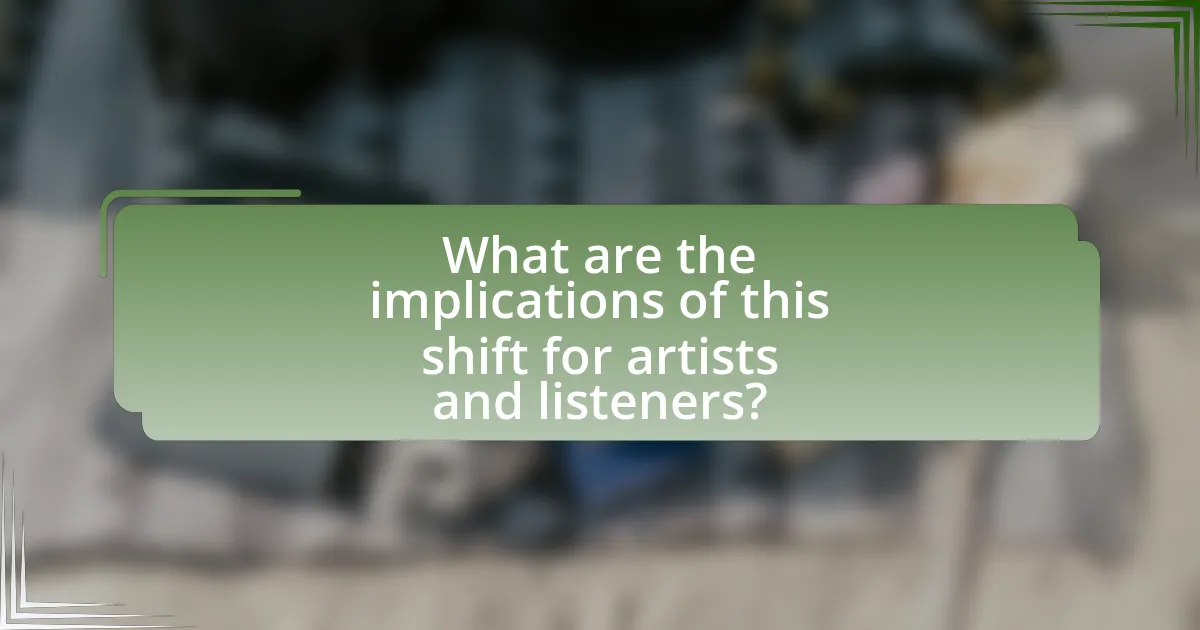
What are the implications of this shift for artists and listeners?
The shift from album releases to singles in pop and rock significantly impacts both artists and listeners. For artists, this transition allows for more frequent engagement with their audience, as they can release new music more regularly, which can lead to increased visibility and potential revenue streams. According to a 2021 report by the International Federation of the Phonographic Industry, singles accounted for 75% of global music consumption, highlighting the trend’s relevance.
For listeners, this shift means access to a continuous flow of new music, catering to the demand for instant gratification in the digital age. The ability to curate personalized playlists with singles allows listeners to discover new artists and songs more easily. This change also reflects a broader cultural shift towards shorter attention spans, as evidenced by research from Nielsen, which indicates that listeners are more likely to engage with shorter formats.
How does the shift affect the creative process for artists?
The shift from album releases to singles significantly alters the creative process for artists by encouraging more frequent and focused content creation. This change compels artists to concentrate on producing individual tracks that can quickly resonate with audiences, rather than investing extensive time in crafting a cohesive album. As a result, artists may experiment more with diverse styles and sounds, leading to a more dynamic and varied body of work. This trend is supported by data indicating that streaming platforms prioritize singles, which can lead to increased visibility and engagement for artists. Consequently, the shift not only impacts the quantity of music produced but also influences the artistic direction and experimentation within the pop and rock genres.
What are the challenges artists face when focusing on singles?
Artists face several challenges when focusing on singles, primarily related to market saturation and promotional costs. The music industry is highly competitive, with numerous singles released daily, making it difficult for individual artists to stand out. Additionally, the financial burden of marketing each single can be significant, as artists must invest in promotional strategies to gain visibility. According to a report by the International Federation of the Phonographic Industry, the average cost of promoting a single can exceed $10,000, which can be a substantial risk for independent artists. Furthermore, the focus on singles can lead to a lack of cohesive artistic expression, as the narrative and depth often found in albums may be sacrificed for the sake of immediate commercial appeal.
How does this shift influence the storytelling aspect of music?
The shift from album releases to singles in pop and rock significantly alters the storytelling aspect of music by prioritizing individual tracks over cohesive narratives. This change leads to fragmented storytelling, as artists focus on creating compelling standalone songs that may lack the depth and continuity traditionally found in full albums. For instance, the rise of streaming platforms has encouraged artists to release singles more frequently, which often results in less emphasis on thematic development and character arcs that are typically explored across an album. Consequently, the storytelling in music becomes more episodic, reflecting immediate emotions or trends rather than a comprehensive narrative journey.
What are the benefits and drawbacks for listeners?
Listeners benefit from the shift from album releases to singles in pop and rock by gaining access to more frequent and diverse music, allowing for a broader exploration of artists’ styles and sounds. This shift enables listeners to discover new tracks and artists more easily, as singles are often released more regularly than full albums, catering to the demand for instant gratification in music consumption.
However, a drawback for listeners is the potential loss of the cohesive storytelling and artistic expression that albums traditionally provide. Albums often present a curated experience that reflects an artist’s vision, while singles may lack this depth, leading to a fragmented listening experience. Additionally, the focus on singles can result in less attention given to the development of full albums, which may diminish the overall quality and creativity in music production.
How does the availability of singles affect listener satisfaction?
The availability of singles significantly enhances listener satisfaction by providing immediate access to new music. This immediacy allows listeners to engage with their favorite artists more frequently, leading to a more dynamic and satisfying listening experience. Research indicates that consumers prefer the convenience of singles, as they can quickly discover and enjoy new tracks without waiting for full album releases. For instance, a study by the International Federation of the Phonographic Industry (IFPI) found that 70% of music listeners prefer streaming singles over albums, highlighting the demand for quick access to new content. This trend reflects a shift in consumer behavior, where the desire for instant gratification in music consumption directly correlates with increased listener satisfaction.
What changes in listening habits have emerged due to this trend?
The shift from album releases to singles in pop and rock has led to a significant change in listening habits, with listeners increasingly favoring shorter, more frequent music consumption. This trend is evidenced by the rise of streaming platforms, where data shows that listeners often prefer to create playlists filled with individual tracks rather than engaging with full albums. According to a 2021 report by the International Federation of the Phonographic Industry, 70% of music consumption now occurs through singles, reflecting a preference for bite-sized content that fits into fast-paced lifestyles. This shift has also resulted in artists focusing on releasing multiple singles throughout the year to maintain listener engagement, rather than investing time in traditional album cycles.
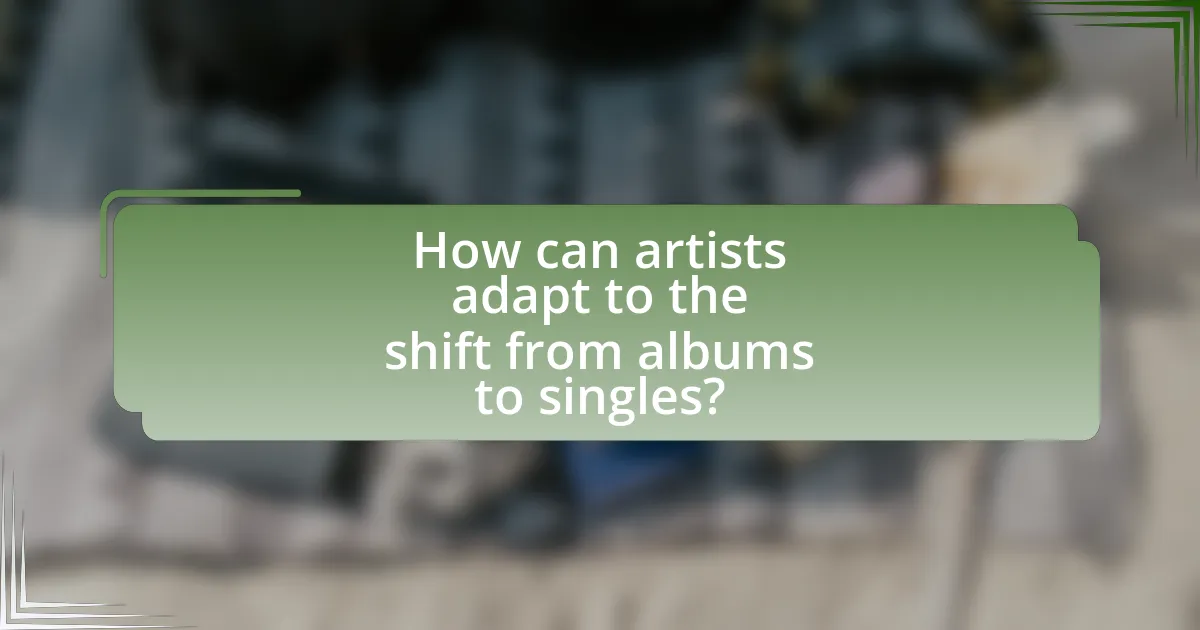
How can artists adapt to the shift from albums to singles?
Artists can adapt to the shift from albums to singles by focusing on releasing high-quality, standalone tracks that resonate with their audience. This approach allows artists to maintain engagement and visibility in a rapidly changing music landscape, where streaming platforms prioritize frequent releases. For instance, data from Spotify indicates that artists who release singles more frequently can increase their overall streams and listener engagement, as listeners are more likely to discover new music through individual tracks rather than full albums. Additionally, artists can leverage social media and digital marketing strategies to promote each single effectively, creating anticipation and maintaining a consistent presence in the market.
What strategies can artists employ to maximize the impact of singles?
Artists can maximize the impact of singles by leveraging targeted marketing strategies, engaging social media campaigns, and collaborating with influencers. Targeted marketing strategies involve identifying and reaching specific demographics through platforms like Spotify and Apple Music, which can increase visibility and engagement. Engaging social media campaigns, including teasers, behind-the-scenes content, and interactive posts, can create buzz and anticipation around the single’s release. Collaborating with influencers can further amplify reach, as influencers can introduce the single to their followers, expanding the artist’s audience. These strategies are supported by data indicating that singles released with strong marketing and social media presence tend to achieve higher streaming numbers and chart positions, as evidenced by the success of artists like Dua Lipa and Lil Nas X, who effectively utilized these methods to enhance their single releases.
How can artists effectively use social media to promote singles?
Artists can effectively use social media to promote singles by creating engaging content that resonates with their audience. This includes sharing behind-the-scenes footage, teasers, and personal stories related to the single, which fosters a deeper connection with fans. Additionally, utilizing platforms like Instagram, TikTok, and Twitter allows artists to reach a broader audience through targeted ads and organic engagement strategies. For instance, TikTok has become a powerful tool for music promotion, with 67% of users discovering new music through the platform, highlighting its effectiveness in reaching potential listeners. Engaging with fans through live Q&A sessions or interactive posts can also enhance visibility and encourage sharing, further amplifying the single’s reach.
What are best practices for releasing singles in today’s market?
The best practices for releasing singles in today’s market include strategic timing, effective promotion, and leveraging digital platforms. Artists should release singles on Fridays to align with industry standards, maximizing visibility during peak streaming times. Utilizing social media for targeted marketing campaigns can enhance audience engagement, as platforms like Instagram and TikTok have proven effective for music discovery. Collaborating with influencers can further amplify reach, as evidenced by the success of tracks that gained traction through viral challenges. Additionally, pre-save campaigns on streaming services can build anticipation and ensure immediate streams upon release, which is crucial for chart performance. These practices are supported by data indicating that singles released with strong promotional strategies see higher initial streaming numbers, leading to better long-term performance.
What resources are available for artists navigating this shift?
Artists navigating the shift from album releases to singles in pop and rock can access various resources, including digital distribution platforms, social media marketing tools, and industry workshops. Digital distribution platforms like DistroKid and TuneCore enable artists to release singles quickly and efficiently, reaching global audiences. Social media marketing tools such as Hootsuite and Buffer help artists promote their singles effectively, allowing for targeted engagement with fans. Additionally, industry workshops and webinars, often hosted by organizations like the Music Business Association, provide valuable insights and strategies tailored to the current music landscape, equipping artists with the knowledge to adapt to this shift successfully.
What tools can help artists analyze their audience engagement with singles?
Artists can utilize tools such as Spotify for Artists, Apple Music for Artists, and social media analytics platforms like Facebook Insights and Instagram Insights to analyze audience engagement with singles. These tools provide metrics on streaming numbers, listener demographics, and engagement rates, allowing artists to understand how their singles are performing. For instance, Spotify for Artists offers detailed insights into listener behavior, including the number of streams, saves, and playlist placements, which are crucial for evaluating audience interaction with singles.
How can artists leverage data to inform their release strategies?
Artists can leverage data to inform their release strategies by analyzing streaming metrics, social media engagement, and audience demographics. By examining platforms like Spotify and Apple Music, artists can identify which songs resonate most with listeners, allowing them to prioritize singles that have higher streaming numbers or engagement rates. For instance, data from Spotify shows that tracks released as singles often achieve greater initial success compared to those released as part of an album, as singles can generate more focused marketing efforts and audience attention. Additionally, social media analytics can reveal trends in listener preferences and optimal release times, enabling artists to tailor their strategies for maximum impact.
